2012 DACIA SANDERO maintenance
[x] Cancel search: maintenancePage 107 of 183
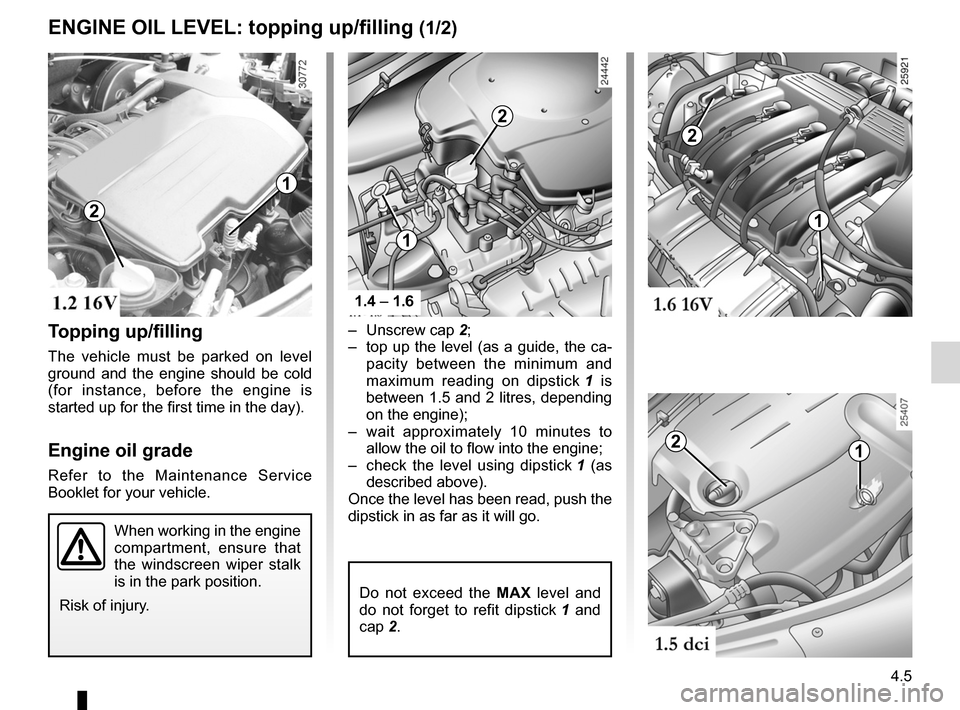
engine oil grade .................................... (up to the end of the DU)
levels: engine oil ......................................................... (current page)
4.5
ENG_UD19757_10
Niveau huile moteur : appoint / remplissage (B90 - L90 Ph2 - Dacia)
ENG_NU_817-9_B90_Dacia_4
Engine oil level: topping up/filling
ENGINE OIL LEVEL: topping up/filling (1/2)
Topping up/filling
The vehicle must be parked on level
ground and the engine should be cold
(for instance, before the engine is
started up for the first time in the day).
Engine oil grade
Refer to the Maintenance Service
Booklet for your vehicle. –
Unscrew cap 2;
– top up the level (as a guide, the ca-
pacity between the minimum and
maximum reading on dipstick 1 is
between 1.5 and 2 litres, depending
on the engine);
– wait approximately 10 minutes to
allow the oil to flow into the engine;
– check the level using dipstick 1 (as
described above).
Once the level has been read, push the
dipstick in as far as it will go.
When working in the engine
compartment, ensure that
the windscreen wiper stalk
is in the park position.
Risk of injury.
2
1
1.4 – 1.6
21
2
1
Do not exceed the MAX level and
do not forget to refit dipstick 1 and
cap 2.
2
1
Page 108 of 183
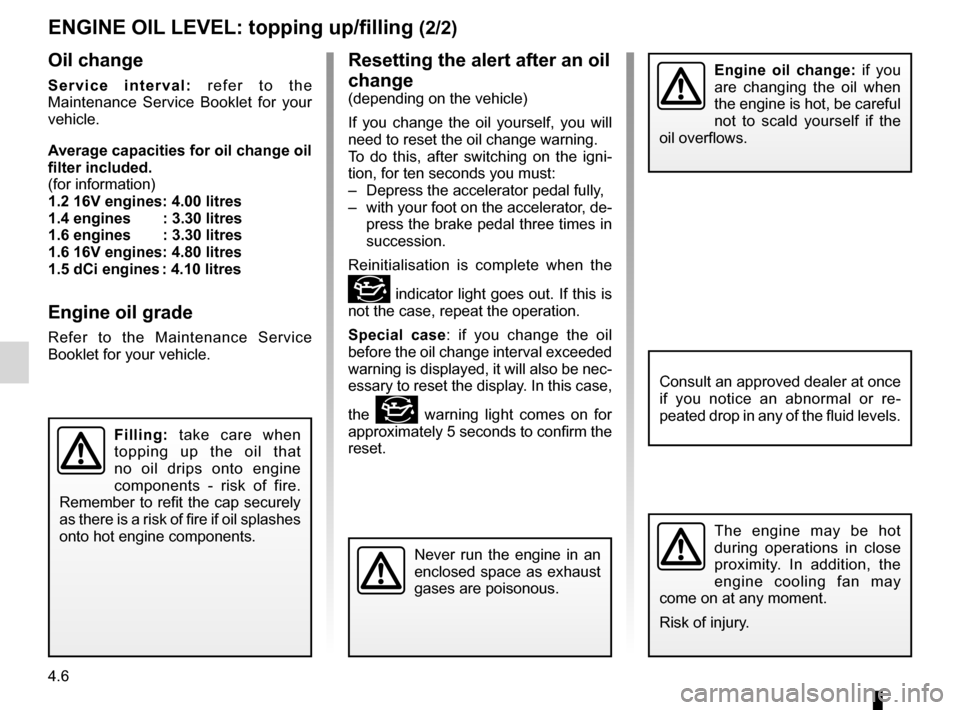
filteroil filter ............................................................. (current page)
oil change .............................................................. (current page)
4.6
ENG_UD19757_10
Niveau huile moteur : appoint / remplissage (B90 - L90 Ph2 - Dacia)
ENG_NU_817-9_B90_Dacia_4
Engine oil change
ENGINE OIL LEVEL: topping up/filling (2/2)
Oil change
S e r v i c e i n t e r v a l : r e f e r t o t h e
Maintenance Service Booklet for your
vehicle.
Average capacities for oil change oil
filter included.
(for information)
1.2 16V engines: 4.00 litres
1.4 engines : 3.30 litres
1.6 engines : 3.30 litres
1.6 16V engines: 4.80 litres
1.5 dCi engines : 4.10 litres
Engine oil grade
Refer to the Maintenance Service
Booklet for your vehicle.
Filling: take care when
topping up the oil that
no oil drips onto engine
components - risk of fire.
Remember to refit the cap securely
as there is a risk of fire if oil splashes
onto hot engine components.
Engine oil change: if you
are changing the oil when
the engine is hot, be careful
not to scald yourself if the
oil overflows.
The engine may be hot
during operations in close
proximity. In addition, the
engine cooling fan may
come on at any moment.
Risk of injury.
Consult an approved dealer at once
if you notice an abnormal or re -
peated drop in any of the fluid levels.
Resetting the alert after an oil
change
(depending on the vehicle)
If you change the oil yourself, you will
need to reset the oil change warning.
To do this, after switching on the igni -
tion, for ten seconds you must:
– Depress the accelerator pedal fully,
– with your foot on the accelerator, de-
press the brake pedal three times in
succession.
Reinitialisation is complete when the
# indicator light goes out. If this is
not the case, repeat the operation.
Special case : if you change the oil
before the oil change interval exceeded
warning is displayed, it will also be nec-
essary to reset the display. In this case,
the
# warning light comes on for
approximately 5 seconds to confirm the
reset.
Never run the engine in an
enclosed space as exhaust
gases are poisonous.
Page 109 of 183
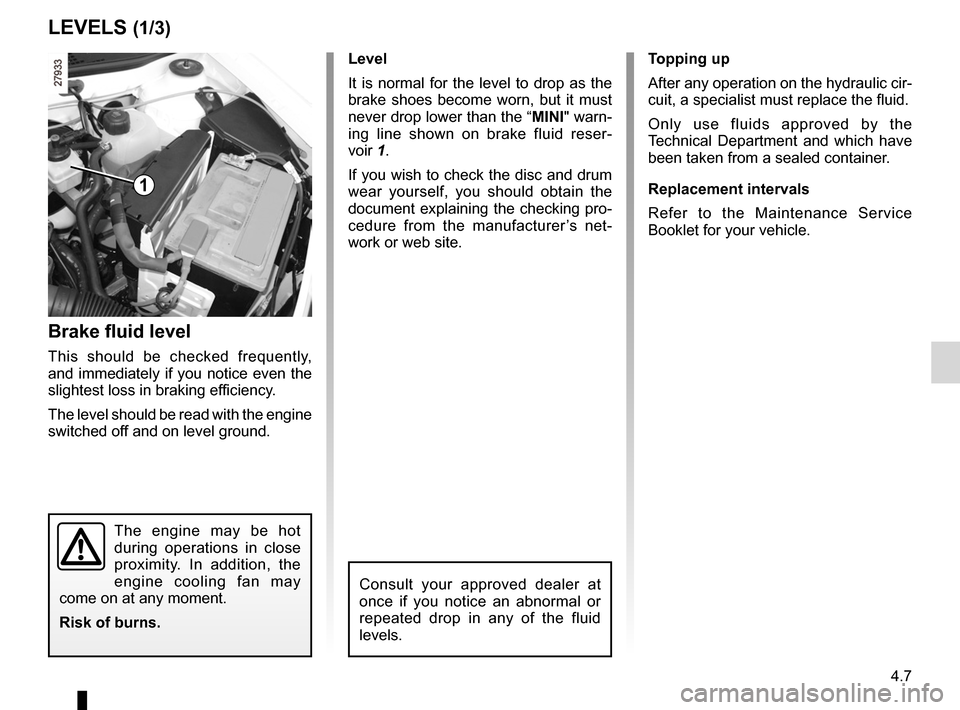
maintenance:mechanical ...................................... (up to the end of the DU)
brake fluid .............................................................. (current page)
levels .................................................... (up to the end of the DU)
tanks and reservoirs brake fluid ........................................................ (current page)
4.7
ENG_UD19766_9
Niveaux / Filtres (B90 - L90 Ph2 - Dacia)
ENG_NU_817-9_B90_Dacia_4
Levels:
Brake fluid
LEVELS (1/3)
Brake fluid level
This should be checked frequently,
and immediately if you notice even the
slightest loss in braking efficiency.
The level should be read with the engine
switched off and on level ground. Level
It is normal for the level to drop as the
brake shoes become worn, but it must
never drop lower than the “MINI" warn-
ing line shown on brake fluid reser
-
voir 1.
If you wish to check the disc and drum
wear yourself, you should obtain the
document explaining the checking pro-
cedure from the manufacturer ’s net -
work or web site.
1
Consult your approved dealer at
once if you notice an abnormal or
repeated drop in any of the fluid
levels.
The engine may be hot
during operations in close
proximity. In addition, the
engine cooling fan may
come on at any moment.
Risk of burns.
Topping up
After any operation on the hydraulic cir-
cuit, a specialist must replace the fluid.
Only use fluids approved by the
Technical Department and which have
been taken from a sealed container.
Replacement intervals
Refer to the Maintenance Service
Booklet for your vehicle.
Page 110 of 183

engine coolant ....................................................... (current page)
tanks and reservoirs coolant ............................................................. (current page)
tanks and reservoirs: windscreen washer .......................................... (current page)
4.8
ENG_UD19766_9
Niveaux / Filtres (B90 - L90 Ph2 - Dacia)
ENG_NU_817-9_B90_Dacia_4
Jaune NoirNoir texte
Engine coolant
Windscreen washer reservoir
Coolant
With the engine switched off and on
level ground, the level when cold must
be between the “ MINI" and “ MAXI"
marks on reservoir 2.
Top this level up when cold before it
reaches the “MINI" mark.
No operations should be
carried out on the cooling
circuit when the engine is
hot.
Risk of burns.
Checking intervals
Check the coolant level regularly
(very severe damage is likely to be
caused to the engine if it runs out of
coolant).
If the level needs to be topped up, only
use products approved by our Technical
Department which ensure:
– protection against freezing;
– anti-corrosion protection of the cool-
ing system.
Replacement intervals
Refer to the Maintenance Service
Booklet for your vehicle.
Consult an approved dealer at once
if you notice an abnormal or re -
peated drop in any of the fluid levels.
LEVELS (2/3)
2
The engine may be hot
during operations in close
proximity. In addition, the
engine cooling fan may
come on at any moment.
Risk of burns.
Windscreen washer reservoir
Filling: Remove cap 3, fill until you can
see the fluid, then refit the cap.
This reservoir supplies the front and
rear screen washers.
Liquid: Special windscreen washer
fluid (anti-freeze product in winter).
Jets: to adjust the angle of the jets
pivot the little ball using a pin.
Use products approved by the Technical
Department.
3
Page 111 of 183
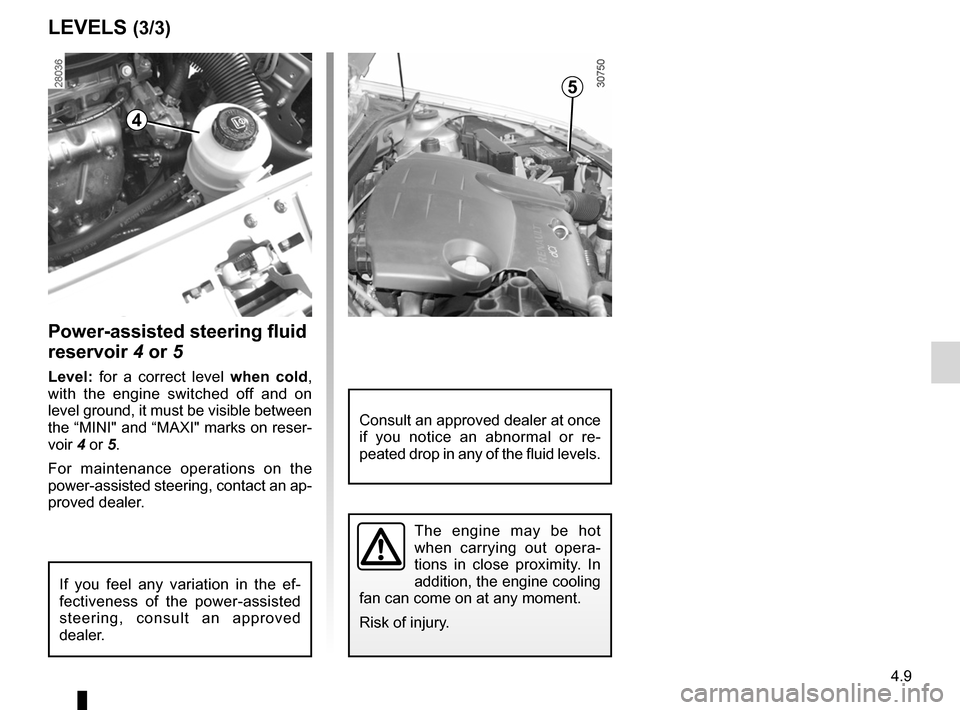
power-assisted steering......................................... (current page)
power-assisted steering ......................................... (current page)
windscreen washer ................................................ (current page)
power-assisted steering pump ...............................(current page)
JauneNoirNoir texte
4.9
ENG_UD19766_9
Niveaux / Filtres (B90 - L90 Ph2 - Dacia)
ENG_NU_817-9_B90_Dacia_4
Power-assisted steering fluid reservoir
LEVELS (3/3)
Power-assisted steering fluid
reservoir 4 or 5
Level: for a correct level when cold,
with the engine switched off and on
level ground, it must be visible between
the “MINI" and “MAXI" marks on reser-
voir 4 or 5.
For maintenance operations on the
power-assisted steering, contact an ap-
proved dealer.
Consult an approved dealer at once
if you notice an abnormal or re -
peated drop in any of the fluid levels.
4
The engine may be hot
when carrying out opera -
tions in close proximity. In
addition, the engine cooling
fan can come on at any moment.
Risk of injury.
If you feel any variation in the ef -
fectiveness of the power-assisted
steering, consult an approved
dealer.
5
Page 112 of 183
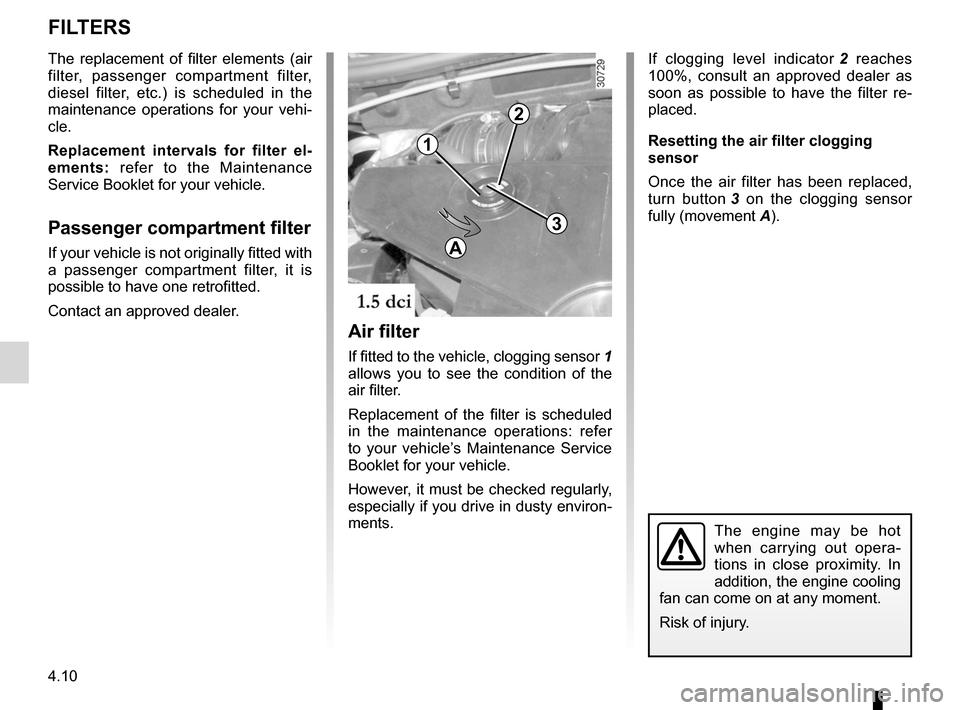
filterair filter ............................................................. (current page)
filter diesel filter ........................................................ (current page)
filter ........................................................................\
(current page)
filter passenger compartment filter .......................... (current page)
4.10
ENG_UD20151_3
Filtres (B90 - U90 - L90 Ph2 - F90 Ph2 - R90 Ph2 - H79 - Dacia)
ENG_NU_817-9_B90_Dacia_4
Filters
FILTERS
The replacement of filter elements (air
filter, passenger compartment filter,
diesel filter, etc.) is scheduled in the
maintenance operations for your vehi -
cle.
Replacement intervals for filter el -
ements: refer to the Maintenance
Service Booklet for your vehicle.
Passenger compartment filter
If your vehicle is not originally fitted with
a passenger compartment filter, it is
possible to have one retrofitted.
Contact an approved dealer.
The engine may be hot
when carrying out opera -
tions in close proximity. In
addition, the engine cooling
fan can come on at any moment.
Risk of injury.
Air filter
If fitted to the vehicle, clogging sensor 1
allows you to see the condition of the
air filter.
Replacement of the filter is scheduled
in the maintenance operations: refer
to your vehicle’s Maintenance Service
Booklet for your vehicle.
However, it must be checked regularly,
especially if you drive in dusty environ -
ments.
If clogging level indicator 2 reaches
100%, consult an approved dealer as
soon as possible to have the filter re -
placed.
Resetting the air filter clogging
sensor
Once the air filter has been replaced,
turn button 3 on the clogging sensor
fully (movement A).
1
2
3
A
Page 114 of 183
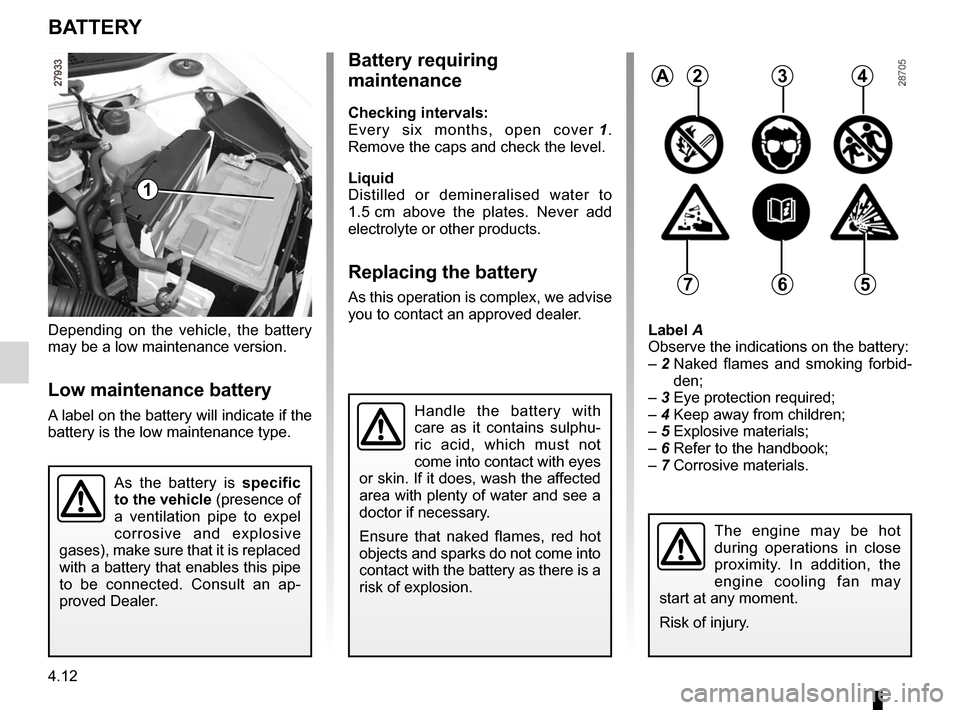
battery................................................... (up to the end of the DU)
capacity of mechanical components ......................(current page)
maintenance: mechanical ....................................................... (current page)
4.12
ENG_UD18253_10
Batterie (B90 - U90 - L90 Ph2 - F90 Ph2 - R90 Ph2 - Dacia)
ENG_NU_817-9_B90_Dacia_4
Battery
BATTER y
Depending on the vehicle, the battery
may be a low maintenance version.
Low maintenance battery
A label on the battery will indicate if the
battery is the low maintenance type.
As the battery is specific
to the vehicle (presence of
a ventilation pipe to expel
corrosive and explosive
gases), make sure that it is replaced
with a battery that enables this pipe
to be connected. Consult an ap -
proved Dealer.
Battery requiring
maintenance
Checking intervals:
Every six months, open cover 1 .
Remove the caps and check the level.
Liquid
Distilled or demineralised water to
1.5 cm above the plates. Never add
electrolyte or other products.
Replacing the battery
As this operation is complex, we advise
you to contact an approved dealer.
Handle the battery with
care as it contains sulphu -
ric acid, which must not
come into contact with eyes
or skin. If it does, wash the affected
area with plenty of water and see a
doctor if necessary.
Ensure that naked flames, red hot
objects and sparks do not come into
contact with the battery as there is a
risk of explosion.
1
Label A
Observe the indications on the battery:
– 2 Naked flames and smoking forbid -
den;
– 3 Eye protection required;
– 4 Keep away from children;
– 5 Explosive materials;
– 6 Refer to the handbook;
– 7 Corrosive materials.
The engine may be hot
during operations in close
proximity. In addition, the
engine cooling fan may
start at any moment.
Risk of injury.
A234
567
Page 115 of 183
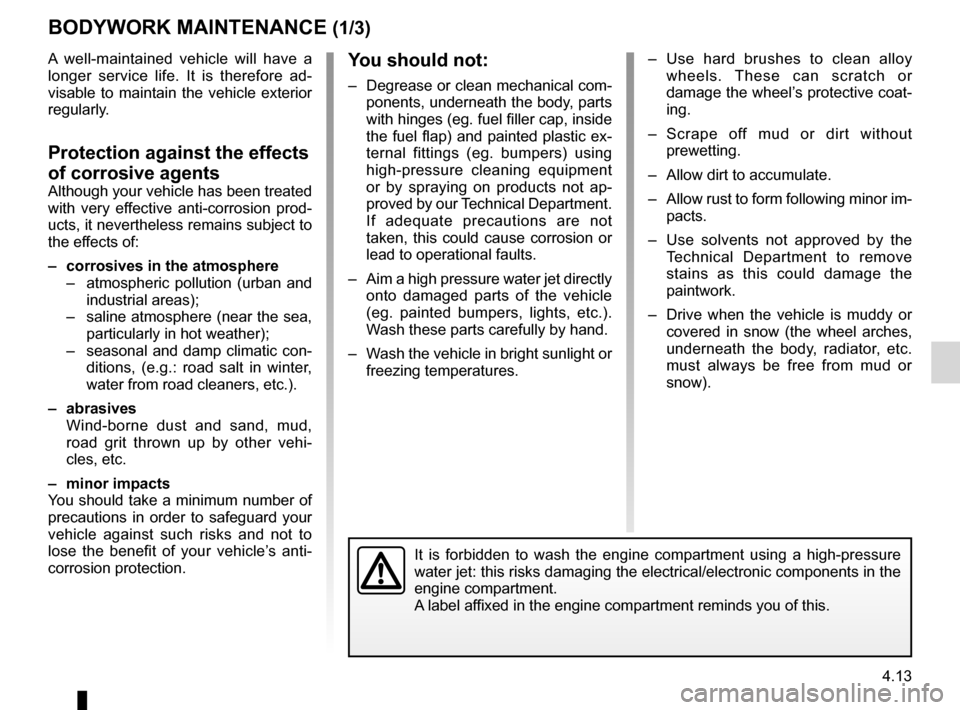
bodywork (maintenance) ...................... (up to the end of the DU)
maintenance: bodywork ........................................ (up to the end of the DU)
washing ................................................ (up to the end of the DU)
paintwork maintenance .................................................... (current page)
4.13
ENG_UD20155_5
Entretien de la carrosserie (B90 - U90 - L90 Ph2 - F90 Ph2 - R90 Ph2 - \
Dacia)
ENG_NU_817-9_B90_Dacia_4
Bodywork maintenance
BODyWORK MAINTENANCE (1/3)
A well-maintained vehicle will have a
longer service life. It is therefore ad -
visable to maintain the vehicle exterior
regularly.
Protection against the effects
of corrosive agents
Although your vehicle has been treated
with very effective anti-corrosion prod -
ucts, it nevertheless remains subject to
the effects of:
– corrosives in the atmosphere
– atmospheric pollution (urban and
industrial areas);
– saline atmosphere (near the sea,
particularly in hot weather);
– seasonal and damp climatic con-
ditions, (e.g.: road salt in winter,
water from road cleaners, etc.).
– abrasives
Wind-borne dust and sand, mud,
road grit thrown up by other vehi -
cles, etc.
– minor impacts
You should take a minimum number of
precautions in order to safeguard your
vehicle against such risks and not to
lose the benefit of your vehicle’s anti -
corrosion protection.
y ou should not:
– Degrease or clean mechanical com-
ponents, underneath the body, parts
with hinges (eg. fuel filler cap, inside
the fuel flap) and painted plastic ex-
ternal fittings (eg. bumpers) using
high-pressure cleaning equipment
or by spraying on products not ap -
proved by our Technical Department.
If adequate precautions are not
taken, this could cause corrosion or
lead to operational faults.
– Aim a high pressure water jet directly
onto damaged parts of the vehicle
(eg. painted bumpers, lights, etc.).
Wash these parts carefully by hand.
– Wash the vehicle in bright sunlight or
freezing temperatures. –
Use hard brushes to clean alloy
wheels. These can scratch or
damage the wheel’s protective coat-
ing.
– Scrape off mud or dirt without
prewetting.
– Allow dirt to accumulate.
– Allow rust to form following minor im-
pacts.
– Use solvents not approved by the
Technical Department to remove
stains as this could damage the
paintwork.
– Drive when the vehicle is muddy or
covered in snow (the wheel arches,
underneath the body, radiator, etc.
must always be free from mud or
snow).
It is forbidden to wash the engine compartment using a high-pressure
water jet: this risks damaging the electrical/electronic components in the
engine compartment.
A label affixed in the engine compartment reminds you of this.